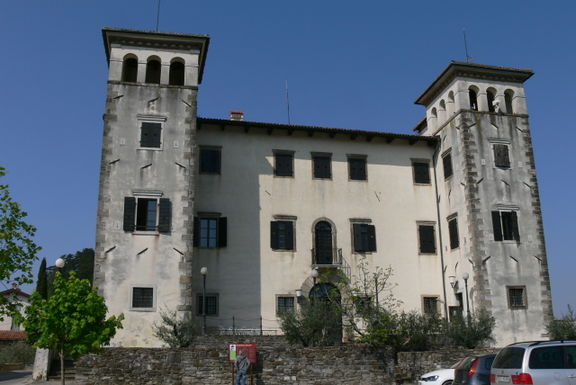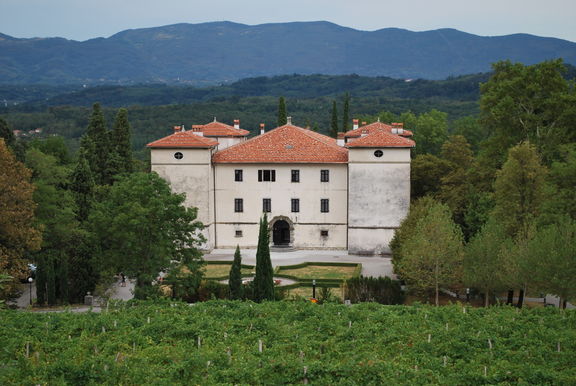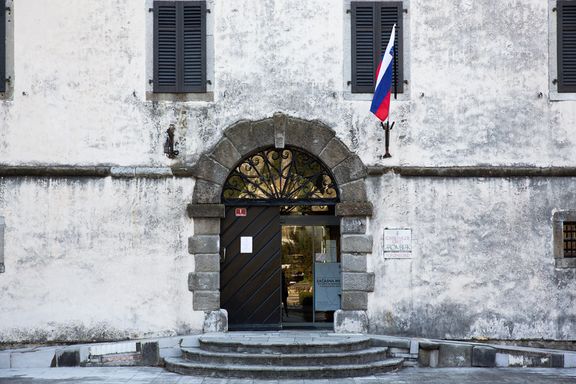Difference between revisions of "Goriška Museum"
(gentle update) |
|||
| Line 8: | Line 8: | ||
| street = Grajska cesta 1 | | street = Grajska cesta 1 | ||
| town = SI-5000 Nova Gorica | | town = SI-5000 Nova Gorica | ||
| − | | telephone = 386 (0) 5 | + | | telephone = 386 (0) 5 333 1140 |
| fax = 386 (0) 5 335 9820 | | fax = 386 (0) 5 335 9820 | ||
| email = goriski.muzej@siol.net | | email = goriski.muzej@siol.net | ||
| Line 14: | Line 14: | ||
| founded by = Municipality of Nova Gorica | | founded by = Municipality of Nova Gorica | ||
| contacts = {{Contact | | contacts = {{Contact | ||
| − | | name = | + | | name = |
| role =Director | | role =Director | ||
| − | | email = | + | | email = |
}} | }} | ||
}} | }} | ||
| Line 22: | Line 22: | ||
{{Teaser| | {{Teaser| | ||
| − | The [[Goriška Museum]], founded in [[established::1952]], is a regional museum covering the historical Goriška region, specifically the part now belonging to Slovenia. Its activities are in the field of history, archaeology, ethnology, art history, and natural sciences. The museum was founded in 1952, two years later it moved to [[Kromberk Castle]] | + | The [[Goriška Museum]], founded in [[established::1952]], is a regional museum covering the historical Goriška region, specifically the part now belonging to Slovenia. Its activities are in the field of history, archaeology, ethnology, art history, and natural sciences. The museum was founded in 1952, two years later it moved to [[Kromberk Castle]]. Today the headquarters of the institution are situated in Solkan. |
}} | }} | ||
| Line 31: | Line 31: | ||
== Programme and mission == | == Programme and mission == | ||
| − | In addition to its traditional museum activities in the fields of history, ethnology, archaeology, art history, and natural history, in cooperation with the [[Idrija Municipal Museum]], the [[Tolmin Museum]], and the [[Pilon Gallery, Ajdovščina]], the Goriška Museum carries out activities in the field of fine arts from the early 20th century onwards. It houses a conservation and restoration workshop in part of the Villa Bartolomei in Solkan. The [[Goriška Museum Library]] keeps the basic methodological books of museology, large collection of foreign professional periodical publications, minority periodical publications, and books concerning Goriška region. The Audiovisual Department documents and presents intangible cultural heritage and collects and keeps audiovisual records. The museum has its depots in Ajdovščina. | + | In addition to its traditional museum activities in the fields of history, ethnology, archaeology, art history, and natural history, in cooperation with the [[Idrija Municipal Museum]], the [[Tolmin Museum]], and the [[Pilon Gallery, Ajdovščina]], the Goriška Museum carries out activities in the field of fine arts from the early 20th century onwards. It houses a conservation and restoration workshop in part of the Villa Bartolomei in Solkan. The [[Goriška Museum Library]] keeps the basic methodological books of museology, large collection of foreign professional periodical publications, minority periodical publications, and books concerning Goriška region. The Audiovisual Department documents and presents intangible cultural heritage and collects and keeps audiovisual records. The museum has its depots in Ajdovščina. The Goriška Museum cooperates with related cultural institutions in the Italian Friuli-Venezia Giulia. |
| − | |||
| − | The Goriška Museum cooperates with related cultural institutions in the Italian Friuli-Venezia Giulia. | ||
== Venues and branches == | == Venues and branches == | ||
| Line 40: | Line 38: | ||
== Collections == | == Collections == | ||
The art history collection includes 143 graphics by [[Zoran Mušič]], art works by [[Avgust Černigoj]] and [[Riko Debenjak]], a collection of graphics by [[Lojze Spacal]]. The cultural-history collection includes the belongings of [[Alojz Gradnik]], the belongings of the Kosove Family. The historical collection contains documents, uniforms, and flags, while the ethnological, archaeological and natural history collections contain items of the Karst countryside as well as fossils from the region. | The art history collection includes 143 graphics by [[Zoran Mušič]], art works by [[Avgust Černigoj]] and [[Riko Debenjak]], a collection of graphics by [[Lojze Spacal]]. The cultural-history collection includes the belongings of [[Alojz Gradnik]], the belongings of the Kosove Family. The historical collection contains documents, uniforms, and flags, while the ethnological, archaeological and natural history collections contain items of the Karst countryside as well as fossils from the region. | ||
| − | |||
== Publishing == | == Publishing == | ||
| Line 46: | Line 43: | ||
== See also == | == See also == | ||
| − | + | Branches | |
* [[Avgust Černigoj Gallery, Lipica]] | * [[Avgust Černigoj Gallery, Lipica]] | ||
* [[Kromberk Castle]] | * [[Kromberk Castle]] | ||
| Line 59: | Line 56: | ||
== External links == | == External links == | ||
| − | * [http://www.goriskimuzej.si | + | * [http://www.goriskimuzej.si Goriška Museum website] (in Slovenian) |
* [http://sl.wikipedia.org/wiki/Goriški_muzej Goriška Museum on Wikipedia] | * [http://sl.wikipedia.org/wiki/Goriški_muzej Goriška Museum on Wikipedia] | ||
Revision as of 16:35, 27 January 2016
-
21 Jan 2018
The exhibition The stamp of Keltic horses' hoofs curated by Miha Mlinar (Tolmin Museum) and Teja Gerbec (Goriška Museum), where the findings from the Bizjak's Homestead in Kobarid and from the Kamenjača in Breza next to Sarajevo are featured together,
-
to
1 Jul 2011
15 Sep 2011
With a Fibula into Fable exhibition organised by Koper Regional Museum, Sergej Mašera Maritime Museum, Goriška Museum, Tolmin Museum, Ptuj – Ormož Regional Museum, and Notranjska Museum, Postojna
History
The beginnings of institutionalised museum activities in Goriška go back to 1861, when Goriška Provincial Museum was founded in the region's centre of Gorica ("Gorizia"), now in Italy. Its collections presented various remains of the region's past without paying attention to individual ethnicity. Exhibitions organised in that period also carefully avoided all references to the presence of Slovenes in the region. The plan to found a national museum in Goriška, presented in the early 20th century, was thwarted by World War I and all of the collected material was lost. During the Italian occupation of Primorska the idea of establishing a school museum here also had to be abandoned. The present museum came about as a result of conditions after World War II, when the new state border between the then Yugoslavia and Italy placed the town of Gorica-Gorizia in Italy and the remaining part of the Goriška region which had previously gravitated towards the town was left without a focus. To replace what was lost, a study library and district museum were established in the fast-growing town of Nova Gorica.
The Goriška Museum had its premises initially within the primary school of Solkan. In 1955 it moved to the restored Renaissance-style Kromberk Castle, an early 17th-century reconstruction of a fortress erected in the first half of the 13th century by Count Henrik of Dornberk. In 1982 the Goriška Museum was grounded as independent institution with four proprietors: the former Municipality of Nova Gorica, the Municipality of Sežana, the Municipality of Ajdovščina, and the Municipality of Tolmin. In 2004 the museum was reorganised by the current Municipality of Nova Gorica as the only proprietor.
Programme and mission
In addition to its traditional museum activities in the fields of history, ethnology, archaeology, art history, and natural history, in cooperation with the Idrija Municipal Museum, the Tolmin Museum, and the Pilon Gallery, Ajdovščina, the Goriška Museum carries out activities in the field of fine arts from the early 20th century onwards. It houses a conservation and restoration workshop in part of the Villa Bartolomei in Solkan. The Goriška Museum Library keeps the basic methodological books of museology, large collection of foreign professional periodical publications, minority periodical publications, and books concerning Goriška region. The Audiovisual Department documents and presents intangible cultural heritage and collects and keeps audiovisual records. The museum has its depots in Ajdovščina. The Goriška Museum cooperates with related cultural institutions in the Italian Friuli-Venezia Giulia.
Venues and branches
The museum's main quarters are in Kromberk Castle. Dislocated units are: Avgust Černigoj Gallery, Lipica; Dobrovo Castle; the Memorial Room of Alojz Gradnik, Medana; the Museum Collection Ajdovščina; the Museum Collection Kolodvor, Nova Gorica; the Museum Collection of the Soča Front at Sveta Gora; the Villa Bartolomei Museum Collection, Solkan; Guard Tower, Vrtojba; Štanjel Castel with Lojze Spacal Gallery and the Karst House, Štanjel; the Memorial Collection of the Kosovel Family, Tomaj; the Trenta Lodge TNP Information Centre and Museum; the Riko Debenjak Gallery, Kanal; and the Memorial exhibition, Cerje (under construction).
Collections
The art history collection includes 143 graphics by Zoran Mušič, art works by Avgust Černigoj and Riko Debenjak, a collection of graphics by Lojze Spacal. The cultural-history collection includes the belongings of Alojz Gradnik, the belongings of the Kosove Family. The historical collection contains documents, uniforms, and flags, while the ethnological, archaeological and natural history collections contain items of the Karst countryside as well as fossils from the region.
Publishing
The Goriška Museum publishes research results of its activities in its own monographic publications and in the periodical publication Goriški letnik, published annually since 1974.
See also
Branches
- Avgust Černigoj Gallery, Lipica
- Kromberk Castle
- Dobrovo Castle
- Riko Debenjak Gallery
- Lojze Spacal Gallery and the Karst House, Štanjel
- Museum Collection of the Soča Front at Sveta Gora
- Trenta Lodge TNP Information Centre and Museum
Libraries
External links
- Goriška Museum website (in Slovenian)
- Goriška Museum on Wikipedia





